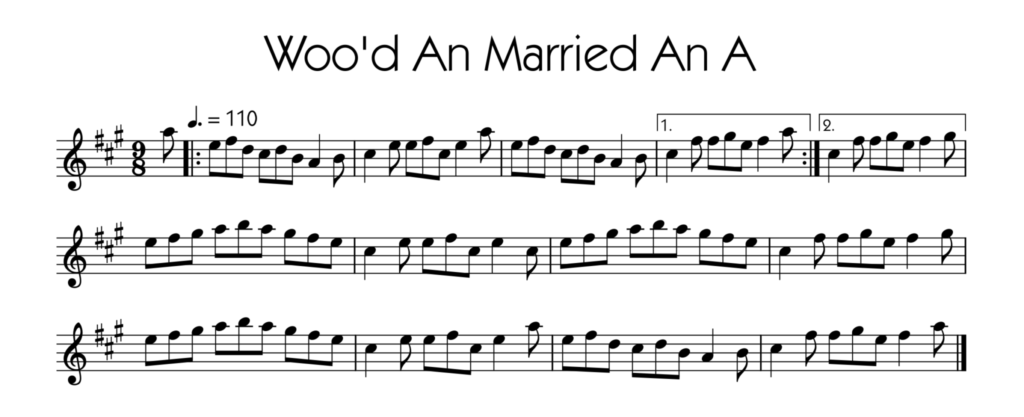Here is a 9/8 jig that testifies to the centuries old desire of pipers to play tunes that don’t quite fit the instrument. The tune first appears in print around the middle of the 1700s but as a song melody is thought to be much older. Almost all the 18th century settings I’ve seen are in G major and include at least one note above the octave and a sharp seventh making it unsuitable for most pipers.

Clearly pipers liked the melody and added it to their repertoires as it starts to appear in dedicated bagpipe collections in the first half of the 1800s. But how to squeeze it onto the pipes? Well all the 19th century collectors settled on leaving the tonic as G allowing them to play both a sharp seventh (F sharp) and one note above the scale (high A). This leads to two problems. First, the drones are in A so sound a bit odd against the G tune and second, what to do about the C naturals (the fourth of the G scale) when most pipers can only play a C sharp. Well all the pipe settings just ignore the problem and play a C sharp anyway, moving the tune from G major (Ionian mode) to G Lydian.

Now there are plenty of pipe tunes that could be said to be in G lydian (although my brain hears many of them as A mixolydian tunes that happen to start with the G chord) and some of them work perfectly well, The Bob of Fettercairn is one of my favourite tunes. I’ve played ‘Woo’d A Married An A’ in that G position for years and it’s always felt a bit awkward. So recently I thought I would make use of my Swayne pipes’ ability to play G sharps and high Bs and transpose the tune up to A. Immediately I realised how compromised the tune is in G on pipes and how true to the song melody it becomes when played in A, so here is my setting as I currently play it in A major.

As I already play the highland pipe setting in G and am very familiar with the song melody, my setting is just how it sits on my fingers in A without too much consideration. I did transpose the old settings to A and play through them to see how they sounded but in my head I mostly had the song melody as a source. The version of the song I am most familiar with would be from Jock Tampson’s Bairns’ 2001 album ‘May You Neve Lack A Scone’.
The Traditional Tune Archive has many settings of the tune plus some annotations on the tune including its many names and concordances. The Irish tune and song air that springs to mind first is Cucanandy but some of the many relations and alternative titles from Scotland, Ireland, England and The Isle of Man are The Bride Cam Out O The Byre, The Irishman’s Choice, My Mind Will Never Be Easy, I Lead Such A Troublesome Life, The New Widow Well Married, Colbagh Breck, The Emigrant’s Jig, The Exile’s Jig, Johnny Came Over The Moor, Tied To A Wife, Marry Them All, The Whistling Thief, Ni Beid Mo Aigne Suaimneac Go Deo, Brouges An Brochan An A and Port An Deoraí.
Below is the tune in ABC notation. ABC is a great way to share simple, single staff notation and is popular amongst traditional musicians. You can learn about ABC notation here and I recommend EasyABC or Michael Eskin’s ABC Transcription Tools to convert the tunes into standard notation, for editing and playback.
X:1
T:Woo’d An Married An A
M:9/8
L:1/8
Q:3/8=110
K:A
a |: efd cdB A2B | c2e efc e2a | efd cdB A2B |1 c2 f fge f2a :|2 c2 f fge f2g ||
| efg aba gfe | c2e efc e2c | efg aba gfe | c2 f fge f2g |
efg aba gfe | c2e efc e2a | efd cdB A2B | c2 f fge f2a ||
Leave a Reply